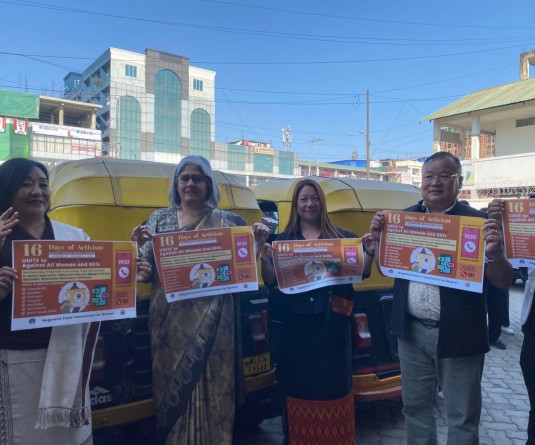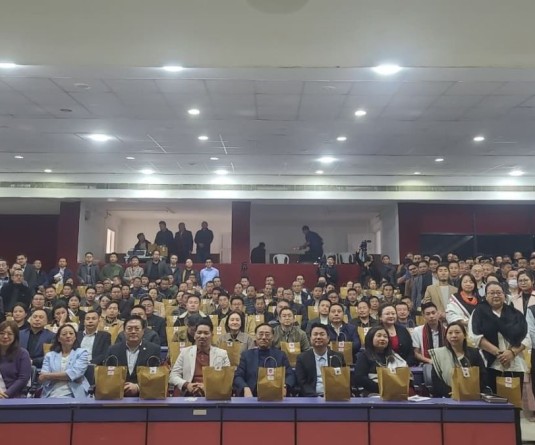
Dimapur, June 13 (MExN): Workshop on ‘Does Nagaland need a policy for Community Conserved Areas? - Policy dialogue was held in PCCF & HOFF conference hall on June 13.
The objective of this workshop is to address the need for a policy on Community-Conserved Areas (CCAs) in Nagaland and to brainstorm on the modalities of developing such a policy including legal, financial and other implications. This workshop is the first in a series under a CI-Japan, GEF-Satoyama sponsored study on, “Mainstreaming Community--Conserved Areas for Biodiversity Conservation in Nagaland’ that is being carried out by TERI with the support of the Nagaland Forest Department.
Neihu C. Thur, Commissioner & Secretary, Department of Forests, Ecology Environment and Wildlife spoke about the community conservation areas and its importance and growing pressure on CCAs.
The keynote address was given by Dr SK Khanduri, IG Forests (Wildlife), Ministry of Environment, Forests and Climate Change. Dr Khanduri emphasized the need for resources to not only strengthen the efforts but also to sustain the ecological, economic and social benefits accruing from the CCAS. He clarified the weight age of 7.5% to forests in the 14th Finance Commission calculations for devolution of central resources is only the beginning of recognition of the state of forest in the economy. “Evolution of models and a policy on CCAs is needed to integrate community level conservation with sustainable forest management in Nagaland,” he added.
Dr Nicky Kire, Minister for Environment, Forest & Climate Change in the inaugural address mentioned that CCAs face numerous challenges, in their creation, effectiveness and sustainability and local people require incentives to compensate for lost livelihood opportunities as productive landscapes and forests are set aside for conservation.
He highlighted that in the long-term, threatening the viability of these forested areas are the lost revenues from timber production. A major issue is foregone benefits from the sale of timber revenues which has significant implications for the sustainability of CCAs. Since many of these CCAs comprise private or clan lands, owners frequently want these areas returned (particularly as forests improve) for their timber revenues. These issues will need to be addressed, particularly since 58% of the village councils reported facing financial constraints and 59% reported incursions of the timber mafia.
Given that only 11.7% of forests are under the governance of the state, Dr Nicky Kire said, these CCAs constitute the primary method for forest management and conservation in the State, in many ways on par with the country’s protected area system. Moreover, these CCAs sequester carbon worth more than 20 crores annually.
Despite their importance, however, there is currently no policy on the CCAs of the State and few funding avenues available. To ensure the future of Nagaland’s CCAs and thereby its forests and biodiversity, a multi-pronged approach including alternative livelihood opportunities through the development of ecotourism, ecological restoration, and long-term ecological monitoring is required, the Minister said. However, of primary importance is the development of a policy on CCAs to buttress state recognition, support and funding of community-managed initiatives in Nagaland, he added.
Dr Pia Sethi, Fellow, TERI has given Introduction to the GEF-Satoyama project: Background, objectives and expectations. A recap of TERI’s work on Community-Conserved Areas in Nagaland done by Siddharth Edake, Associate Fellow, TERI. Community representatives from Sendenyu, Sukhai, Khonoma, Y Nuklu Phom Secretary Phom Baptist Church Association gave perspectives on Community-Conserved Areas. Tokaho, DFO, Zunheboto spoke about Challenges in initiating CCAs.
Discussion session taken by M Lokeswara Rao, Principal Chief Conservator of Forests and Head of Forest Force, Government of Nagaland. Concluding remarks were given by Dr JV Sharma, IFS, Senior Fellow, TERI and M Lokeswara Rao and Temjen Yabang Jamir, IFS, CF (Pub) gave the vote of thanks.
Renew traditional conservation and forest management
Giving the introductory remarks, JV Sharma, IFS, Senior Fellow TERI said that in Nagaland, traditional conservation and wise use practices have helped protect biodiversity over the centuries.
He said that in Nagaland, customary rights are protected under Article 371 A of the Constitution and about 93% of natural habitats (largely forests) are owned by individual clans, village, district councils and other traditional community institutions. Hence, customary land ownership and management practices characterize forest management in Nagaland, and the local people are empowered to manage their forests under the Nagaland Village Council (third Amendment) Act, 2002 which grants the Village Council the powers and duties ‘to supervise proper maintenance of forests.’
Escalating pressures on forests for multiple uses, has, however, adversely impacted the forests and local people, given their dependence on forest cover for a variety of provisioning and regulating ecosystem services. These livelihood issues form a major impetus for the creation of Community-Conserved Areas in the State to help conserve and protect key ecological interactions and ecosystem services.
The revival of traditional conservation and forest management practices through the creation of CCAs, offers hope for forest protection and biodiversity conservation, as communities set aside parcels of forests within productive, jhum (shifting cultivation), landscapes.
A study of Nagaland’s CCAs conducted by TERI and the Forest Department of Nagaland found that almost one-third of Nagaland’s villages have constituted CCAs and as many as 82% of these 407 CCAs have completely or partially banned tree felling and/or hunting within the CCAs and enforce various regulations for forest protection (TERI, 2015). These CCAs which cover more than 1700 sq. km, by setting aside forests for conservation, also contribute extensively to carbon storage (an estimated 120.77 tonnes per ha (TERI, 2013), reduce emissions from deforestation and degradation, and are an important mitigation and adaptation strategy for climate change.






